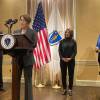What Maura Healey does when she moves into the governor’s suite on Jan. 5 is still an open question.
In the weeks since they were elected, Healey and running mate Kim Driscoll have kept fairly quiet about specific post-inauguration plans, working behind the scenes to build their team and write their agenda.
Along the way Healey has hinted about her agenda: She’s said housing will be a priority, and wants a dedicated Cabinet secretary for that issue. She’s signaled an interest in early action on tax reform, and proposed an expanded child tax credit on the campaign trail.
And then there are the inescapable big-picture efforts like helping schools continue to bounce back from the pandemic and addressing workforce shortages that hamper the health care system.
Important issues, yes; but relatively speaking, low-hanging fruit.
Transportation
As her administration takes shape, the new governor and her team should be thinking about both matters that will require attention in their first few months and their longer-range ambitions, said Jim Aloisi, a former state transportation secretary.
Along with hiring a new MBTA general manager, making sure highways can withstand January snow and planning for an upcoming shutdown of Boston’s Sumner Tunnel, Aloisi said Healey can demonstrate commitment to both public transit and economic development by advancing a connection between the MBTA’s Red and Blue Lines.
"The virtue of the Red-Blue connector is, it's one of the most affordable projects that the new administration can undertake in an effort to be truly forward-looking and transformational, and it is a project that really is important, I would argue, for the post-pandemic regional economy," he said.
The connection — long sought by advocates to better join the Kendall Square biotech hub with Logan Airport and improve mobility for Revere, East Boston and Dorchester — is one of a slew of projects somewhere in the T’s pipeline, but it hasn’t risen to priority status. A 2021 report tallied its cost at $850 million and projected it could be complete by 2030.
Aloisi said there’s a window for Healey to make significant strides on the project, harnessing support from Boston officials and the opportunity created by major construction at nearby Massachusetts General Hospital.
Education
When Massachusetts voters elected Healey, they also approved a new tax on incomes over $1 million to generate funding for transportation and education.
The tax is projected to yield upwards of $1 billion in new revenue. It won’t all materialize until people start paying their 2023 taxes, but competition for the new dollars — and remaining federal COVID-19 relief funds — is already underway.
A teachers union-backed coalition is eyeing the surtax money to make college more affordable, boost student support, raise faculty and staff pay, and otherwise invest in public higher education.
A separate group, Student Pathways to Success Coalition, is pushing for expanded access to programs where high schoolers can earn college credit or work experience. That group may have an ally in Driscoll, who spoke at a recent webinar it hosted.
Ed Lambert of the Massachusetts Business Alliance for Education, who emceed that event, said the incoming administration should also focus on helping students recover from the COVID-19 pandemic’s disruptions to both learning and social-emotional development.
"I expect, not that I have any particular insight, that the first order of business will be how do we address that," Lambert told GBH News. "We've got the moment and the opportunity and the challenges all converging, and the resources to do it with."
More Politics
Labor market shortages
The pandemic changed the nature of work and its ripple effects have created or exacerbated workforce shortages across industries. To keep the state’s economy humming and make sure people can access services they rely on — like early education, public transit and health care — efforts to train, find and keep workers will need to be on the agenda.
A report from the Blue Cross Blue Shield of Massachusetts Foundation flagged “mitigating critical health care workforce shortages" as one of five top health care priorities for the new administration.
Stephanie Anthony, a senior advisor with the firm that worked on the report, Manatt Health, said the health care system accounts for about 18% of the state’s workforce. She said behavioral health and long-term care were already shorthanded pre-pandemic, and one of the report’s recommendations is for the new administration to work to boost pay in those fields.
“Historical underinvestment in those workforce sectors has suppressed worker wages, salaries and benefits,” Anthony said. “They’ve either been stagnant for years or persistently below other parts of the workforce and often below living wage in Massachusetts. This has made it difficult to recruit and retain these workers at a time when these demanding professions are in high demand.”
Geoff Beckwith, executive director of the Massachusetts Municipal Association, said worker shortages are a “hidden issue” in local government, too.
“The municipal workforce is aging out,” he said. “Communities are really finding it increasingly difficult to be able to find municipal finance professionals, engineers. It’s hard to get people to apply to be police officers, or water treatment plant officers. Building inspectors. Assessors. Those are all really important jobs, but communities are having a hard time finding that talent.”
Sustainability and climate
It’ll fall to Healey and her deputies to implement many laws passed this year, including finalizing rules for a pilot letting 10 communities ban fossil fuelsin new construction, created under a climate law Baker signed.
Her administration will need to help Massachusetts meet the state’s commitment to reach net-zero carbon emissions by 2050 and the interim targets along the way.
Responding to climate change is no small feat, and major emissions sources like transportation and the heating of buildings will likely be on Healey’s mind.
Janet Domenitz, the executive director of MASSPIRG, said the Healey administration can also make moves on another environmental issue: the millions of tons of waste Massachusetts disposes of annually.
MASSPIRG is a member of the Zero Waste Coalition, which offered a list of 10 zero-waste ideas for the next governor. Some, like banning single-use plastic bags, involve the Legislature, but there are also steps the administration can take on its own, like strengthening enforcement of existing bans on throwing out recyclable materials.
“I don’t think that this is a huge ask,” Domenitz said. “We have a lot of problems that are difficult, even though we have to solve them, but if you look at this list it’s pretty straightforward. We just have to commit.”
For Healey’s part, the governor-elect said she welcomes input from all corners of the state.
“While there are some things that we’ve thought about, no doubt, I know that there are a lot of good ideas that are still out there that are going to come our way,” she said.









